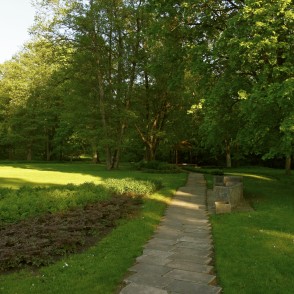Formerly Baldone has been famous for its natural healing resources - healing mud and mineral springs, as the healing properties of sulphur water provided Baldone a boom and recognition in both Latvia and elsewhere in the world. Those natural healing resources are still in Baldone.
Lilac Park
The stories show that the park was a favourite meeting place among the visitors of the health resort. For centuries, life has been boggling here, in the 1930s there even was a newspaper and a sweet kiosk. In 1984, in honour of the sulphur spring, a memorial stone was installed with the inscription “Baldone sulphur spring has been used in medicine since 1186.” The Lilac Park acquired its name in 1985. Pavilion “Ķirzaciņa” provides access to the sulphur spring from where the supply is provided also to the fountain-sculpture “Māra” and “Vāverīte”.
Pavilion “Ķirzaciņa”
At the end of the 19th century, a new sulphuric water tank “Muciņa” (Barrel) was constructed in place of the old sulphur vessel. It had a closed wooden gable above it. A pipe led water from the tank to the sculpture “Muciņa” where the water was available for general use. Later, a sculpture “Ķirzaciņa” (Lizard) was installed above the tank. In the 1930s, a new pavilion was built above the sulphur plant the provided further sulphur water supply from the 10th borehole. In 1955, after rebuilding of “Muciņa” water tank the sulphuric water discharged from the mouth of “Ķirzaciņa”. In 1994, the sculpture “Ķirzaciņa” was stolen and by 2017 the sulphuric water flew out of a pipe. In 2017, the city began pavilion reconstruction along with creation and installation of a prototype of the sculpture “Ķirzaciņa”, thus completing the renovation of the park’s fountains.
Fountain – sculpture “Māra”
Historically, next to the sulphur-water extraction place “Ķirzaciņa” was also a sulphur water collection site “Māra”, which depicts the guardian of healing water St. Māra. The sculpture was set up in 1940 before the World War II, and it was made by sculptor Voldemārs Jākobsons. The story goes that once a beautiful but blind girl Māra washed her eyes with the sulphuric water and regained her sight. In 1970, the sculpture was stolen but later found, however, in 1996 it was damaged. In 2015, from a stone found in Iecava district sculptor Valtis Barkāns created a prototype of the sculpture.
Fountain – sculpture “Vāverīte”
The fountain – sculpture “Vāverīte” (Squirrel) was installed in the park in 1937. Sculptor Voldemārs Jēkabsons created it commissioned by the Latvian State Resort Authority. The sculpture is a squirrel-shaped figure with a cone in her hands, which is also the symbol in the coat of arms of Baldone district. This just like the other sculptures also was stolen. In 2017, 26 years past the restoration of independence of the Republic of Latvia, a sculpture was created and installed in the park again. It is a little bigger than the old one, as it symbolizes the growth and development of the Baldone region. The author of the new sculpture is sculptor Tālivaldis Muzikants, director of the Baldone Art School.
Baldone Sulphur Spring and its healing properties
Baldone sulphur springs flow through peat and gypsum-containing rocks. The water is rich in hydrogen sulphide and carbonic acid. The springs flow from the same layers of gypsum, in which famous Ķemeri water sources begin. The water is colourless, clear, with a bitter flavour and a strong, characteristic egg-like odour. In Baldone, to the public the best accessible water extraction site is in Lilac Park.
Sulphuric water has several healing properties. Sulphur baths increase body's tonus, improve blood circulation and metabolism. Orally sulphuric water is used to treat digestive and metabolic diseases, nervous system and cardiovascular diseases as well as skin and gynaecological diseases. Inhalation is used to reduce respiratory symptoms. The sulphuric water is widely used for bathing, drinking, rinsing, inhalation and physiotherapy in the pool. Baldone Sulphur Spring is included in the list of State protected cultural monuments.
The sulphur water was historically used by healers
Over the centuries the miraculous sulphur ability to heal diseases brought to Baldone thousands of summer visitors and sick people. There were stories about the curative properties of water that one can improve eyesight when rinsing eyes with the spring water. Out of thankfulness people threw in the spring donations – jewellery, money. Until the 15th century, there is no written evidence on the use of the spring water, it is only a legend that it was used by healers. Its use was related to the belief in supernatural powers. In the 15th century the first written testimony appears, stating that at that time the water was used by the Livonian Order's masters and their companions calling it “the source of youth.”
In 1797, when the Baldone resort was founded, a roof was installed above the sulphur water extraction site along with an inscription in 3 languages: German, Latin, and Russian. “HEILUNG DEM KRANKEN, FREUDE DEM GESUNDEN. AEGROTIS SALUTI, SANIS LAETITIAE. БОЛЬНОМУ ИСЦЕЛЕНИЕ, ЗДОРОВОМУ УВЕСЕЛЕНИЕ.” There was no translation in Latvian.
The inscription means: “CURE THE SICK, JOY THE HEALTHY.”
Park visitors are welcome to taste the curative sulphur water!
Location:
Ceriņu parks, Rīgas iela 54, Baldone, LV -2125
www.baldone.lv

















